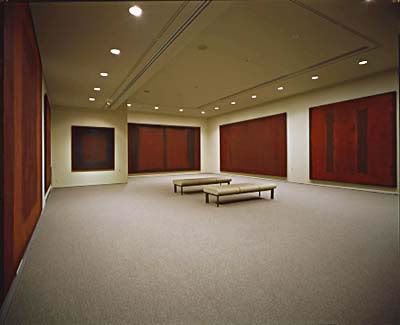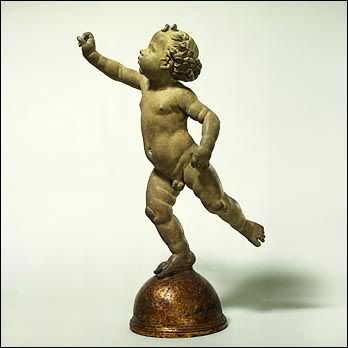

'Putto Poised on a Globe', forged of unbaked clay by Andrea Verrochio, in approximately 1480 A.D., and Mark Rothko's 'Chapel Murals', 1962-1967, oil on canvas, both nudge one to ponder the 'Sacred Realm', as did many Pre-Socratic philosophers. These compositions(p.121) seem to raise the timeless philosophical questions on, the nature of being, knowledge and values.
The 'Sacred Realm'(p.52) cannot be experienced with the human senses, though, some artists and philopsophers throughout the aeons have directed their creative energies toward making concrete form of these abstract ideas. This is a complex and mysterious role. Both Rothko and Verrochio assume this role in their artistic endeavours.
In Verrochio's 'Putto Poised on a Globe', the emphasis is not directed to the chubby child-like cherub figure, but is actually focused on Putto's or 'ones' transcendence or liberation from the visible physical manifestation itself. The decisive upward-diagonal lines flowing through the piece create a movement away from, both, Putto and the globe itself; then they take off and dissapear into an invisible space or realm where they have traveled for an eternity. The piece, through it's composition and visual design elements, such as line and space, evoke a childlike emotion of curiosity, both, literally and figuratively. Mark Rothko, composed the 'Chapel Murals' during a post World War II art movement called Abstract Expressionism(p.539), of which Rothko consciously directed his focus on a form of abstraction called Color Field painting. He, Rothko, wanted to create a sensation of pure dematerializaed color. He achieved this by featuring one or more soft-edged color rectangles floating in a larger color rectangle on the canvas. Rothko thinned his paints so much that the pigment powder barely held to the canvas. Again, driven by the reaccuring theme of the invisible realm in which the focus is not of the 'thing' itself but of it's 'form'. Rothko's art through it's meditative tranquility, draws the viewer into this realm and invites contemplation.
Not only do both artists explore this 'sacred realm', they bring back remnants of a distant journey into space, that formalize that contact between the eartlhy and divine realms.
All page numbers are in reference to terms found in Mark Getlein's text, 'Living With Art'.

No comments:
Post a Comment